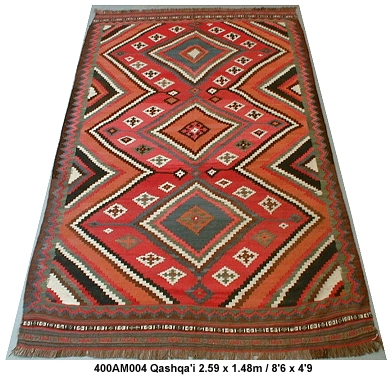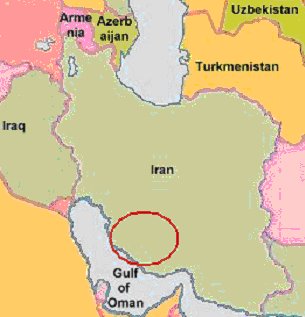

 |
|
Origin: Qashqa'i
Southern Iran
Woven: c. 1920
Size: 2.59 x 1.48m / 8'6" x 4'9"
Ref: 400AM004
Price Euros 1750
Originally known for their long 500 km migration made each year from the Persian Gulf to their summer pastures in the Zagros Mountains, the Qashqa'i remain to this day a nomadic tribe, although successive repressive regimes after 1925 have tried to restrict their nomadic activities. As a consequence their best rugs were made before 1925, although between 1941 and 1956 the tribes people enjoyed a brief return to self-government and traditional lifestyles. Today, with the continuing attempts to create a homogenous Iranian society by the current Islamic government, the Qashqa'i now occupy an area of the Fars region in Iran around the city of Shiraz, and still continue to produce some kilims, although largely for commercial reasons. Previously some Qashqa'i weaving was carried out during migrations, and so portable ground looms were used, re-erected and dismantled at each resting place. This resulted in a variation of the tension, so these kilims sometimes became curved or had irregular edges. More recently less weaving was done on the migratory journey, most of the activity being during the summer when established in the mountains. However the Qashqa'i retained their traditional styles of motifs, patterns, colours and techniques from their fully migratory days. In order to help to achieve their vibrant colours, the Qashqa'i actually scoured the wool in boiling potash solution to remove excess fats and lanolin, unlike other Persian nomadic weavers, who often left the wool unwashed. All these factors add to the charm of these fabulous kilims, immediately recognizable by their large geometric designs, both diamonds and squares, and strong and clear colouring, including unusually sharp yellows, and bright whites typical of undyed cotton. Sometimes a smaller (checkerboard) basic pattern was used, but also surrounded by the characteristic reciprocal border often found in Persian tile mosaic decoration. On this particular example, the large geometric design, the Turkic cross-like motifs (thought to ward off the "evil eye"), the characteristic rows of weft patterning on the end panels and of course the vibrant colours, typify the artistry of the Qashqa'i weaver.